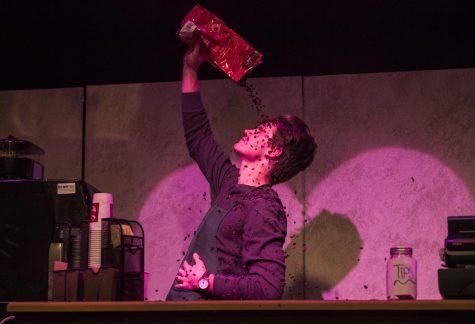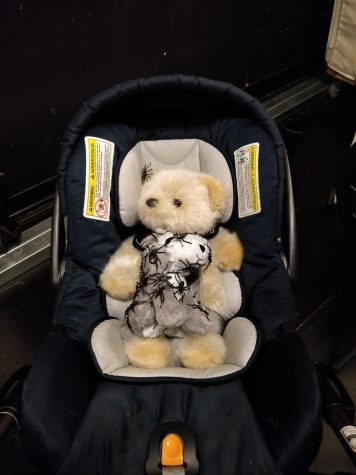One Acts
When I was in eighth grade, I attended Stevenson’s largest theater production of the year, Cabaret. Despite not being a theatre aficionado or expert, I really enjoyed the performance and was mesmerized by the professionalism and the complexity of the production. As a result, I went ahead and attended Miss Saigon my freshman year, and the reaction was still the same. I was shocked at the talent and the dedication these students had. However, I’m ashamed to admit that I hadn’t been to any theatre performances since then, until I decided to attend One Acts on Saturday, April 21st.
One Acts is an annual theater event that consists of a series of shorter, smaller plays, each of which has (surprisingly enough) one act and a couple cast members. The coolest thing about One Acts is the fact that it is entirely organized and put together by students. Whether it was writing, editing, directing the plays, acting on stage, designing props and costumes, controlling sound and light systems, or working backstage, the entire production was run by students.
The lineup this year consisted of an eclectic mix of all sorts of plays: funny and dark; silly and thought-provoking; serious and light-hearted. But the one thing that united all the plays was vision. For every play, there was a meaningful reason for writing it, an inspiration or a motivation. For one writer (Angela Spilotro ’19), it was the death of a close relative. For another (Elliot Koriath ’19), it was watching Judge Judy and wanting to write a parody. For yet another playwright (Lydia Johnson ’18), it was her experiences with a Starbucks barista, and for Ananya Shah ’19 , it was the gender roles enforced by media. Regardless of the subject matter of the plays themselves, every writer had a unique, personal, and powerful reason to write the play.
That motivation paid off, as it was obvious to me that the students legitimately cared about their productions. The performance was exhilarating, and made me wonder exactly why I hadn’t attended more theatre performances at Stevenson. I was awed by the talent that my fellow peers possessed and utilized. The directing and the acting made me feel as though the scenes were real, and I felt as though I was in the middle of the scene occurring in real life. Stellar performances by the entire cast despite the unconventional roles truly made the experience a beautiful one, and suffice it to say, the audience was spellbound. For most of the performance, there was either uproarious laughter or overwhelming silence from the audience, and it was clear that everyone in the room (it was a full house) was enjoying themselves. Although the performance wasn’t as large of a production as Miss Saigon (there was a spider lowered from the roof instead of a helicopter), it was the culmination of months of hard work on the part of everyone involved.
What I found most impressive was the behind the scenes work to make sure everything ran smoothly. While their roles weren’t necessarily acknowledged or as visibly appreciated by their audience, the work they put in was absolutely essential to creating such an incredible performance. I was lucky enough to be offered the VIP experience. The sound designer, Filip Graniczny ’19 was kind enough to walk me through the entire production process and show me all the moving parts in action. He was in charge of the audio and sound effects during the show, and had to arrange all the audio and video clips, as well as intro and outro music, at the precise time. During the halftime break, he found the time to introduce me to a large crew who were in charge of all the elements backstage. Forgive me for not remembering names, but I got to talk to the stage crew, prop managers and designers, costume crew and designers, and the stage manager.
All in all, I met at least a dozen people in less than ten minutes. In the midst of all the hustle and backstage work, I found myself talking with a couple students who were part of the backstage crew, and realized that there were indeed more moving parts than any audience manager would ever imagine.
The stage crew was in charge of setting up and taking down props in between each play. They were onstage at times in between plays, moving life-size lockers and tables and an incredibly odd assortment of other props on and offstage in an incredibly short amount of time. They also had to clean the stage when the actors caused a mess, such as in this scene.
 (Photo by Joel Lerner)
(Photo by Joel Lerner)
However, they also had a few close calls, as one member recalled. She mentioned one incident in which an actor left a prop onstage after their play. “I had to crawl onstage and grab it while the next scene was ongoing.”
While the stage crew was working on setting up the stage, other groups were fulfilling their roles to make the performance as smooth as possible. The costume crew, led by Aliceson Hackett-Rubel, was in charge of designing and fitting costumes. While a lot many of the costumes were store-bought, alterations needed to be made in order to make the costumes truly fit the characters and the roles.
For some of the more unconventional costumes, extra work was needed to design the costume. The animal costumes in “Arachno Woman No Cry” are a perfect example. For Diego’s (Sam Litwin ’18) costume in “Foreign Exchange: Un Solo Acto”, the costume designers needed to cut a hole in the costume for Litwin to strap on a guitar, and his hat was modified as well. For the costume designers, the work for this performance started well before show night.
Another group that worked the same way was the prop crew. The prop managers had to design props for the show, a daunting task given the variety of props needed and the number of plays they had to acquire props for. In particular, this spider stroller, used to carry a litter of baby spiders in “Arachno Woman No Cry”, required a significant amount of effort on the part of Abby Sokol ’20 and Emily Feldman ‘20. They used a hot glue gun to glue each spider onto the stroller, a tedious and time-consuming task that is a testament to this crew’s attention to detail.

After stepping backstage for just a few minutes, I was amazed and had developed a new sense of appreciation for all the work that I didn’t really consider during the first half. From there, I went up to the sound and lighting booth, where Graniczny introduced me to Tyler Goggin ’21, who ran the soundboard. From this part of the West Auditorium, I was able to see how the sound systems were being operated and controlled. I also got to meet Stark Winter ’19, the lighting designer and light board operator.
The technical work that this crew did was just as important as the work done backstage by the stage, costume, and prop crews, and kept the show running and functional. The lighting, audio, and special effects played major roles in certain plays, and the work of this crew was essential to making the performance even more engaging and emotionally arousing. The special effects also played a major role, as there were foggers and special lighting (such as strobe lighting) that played significant roles in numerous plays.
I couldn’t chat for long, but talked to Graniczny for long enough to realize that I really didn’t fully understand the complexity of the audio and lighting systems. He attempted to explain it to me a couple times, but to no avail. As the second half of the show began, I found my seat and began watching again, spellbound this time not only by the actors on stage but also by the many cogs of the well-oiled machine that allowed the production to run at such a high standard.

